Are seeds and nuts good sources of protein? While they’re not the leanest protein sources available, some tout a respectable amount of protein and are rich in fiber, vitamins, and minerals. They’re also great protein options for those looking to avoid meat and the highly processed meat alternatives.
If you’re anything like me, you want a straightforward list ranked from the best nuts for protein to the worst. So that’s exactly what I’ve done. In this case, I’ve defined “best” by calculating the percentage of calories in a 1-ounce serving that comes from protein.

For example, the highest protein nuts by percent of calories from protein are peanuts (which are actually legumes), with 7 grams of protein per 165-calorie serving. With 4 calories per gram of protein, that equates to 28 calories from protein. And 28 divided by 165 is roughly 17%.
I used this same formula and nutrition data from the USDA Food Database to rank 20 nuts, seeds, and legumes from highest to lowest protein content.
Since this guide is a result of my curiosity from developing my high protein trail mix recipe, all the nutrition data was calculated on 1-ounce servings of dry roasted variations. An ounce of most nuts and seeds equates to 1/4 cup, in case you’re curious.

My Top Picks
Before we get to the straight up rankings by math, I wanted to hit you with my personal top 5. Keep in mind, I’m writing this from the perspective of someone eating a higher protein, calorie conscious diet. The fat content in nuts make them tricky to eat without overdoing the daily calories.
You might be surprised to see the first nut that’s truly a nut, pistachios, not even crack the top 5 on the percentage of protein. It’s actually number 8 behind seeds and legumes. The clear superstar on the list is dry roasted edamame, coming in with a whopping 14 grams of protein and 43% of calories coming from protein. You also get 6 grams of fiber per serving.
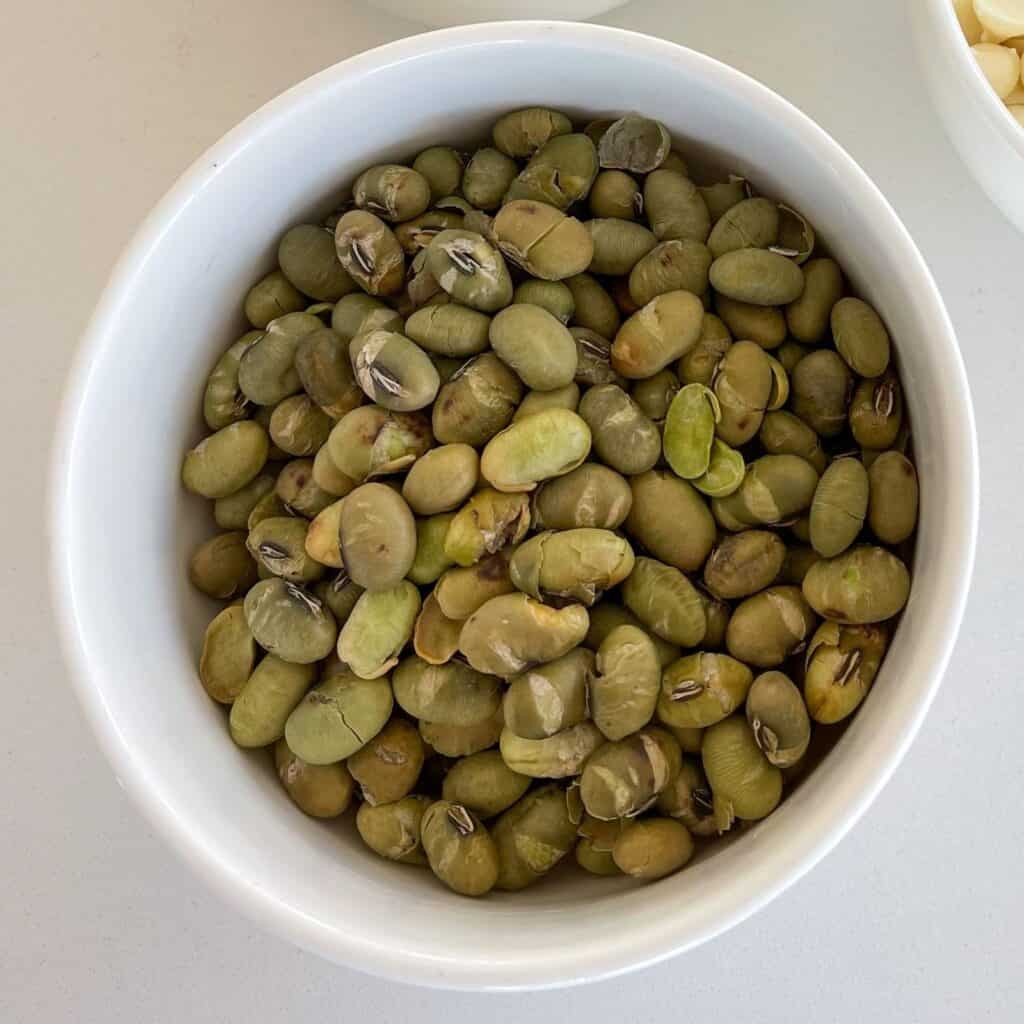
Rounding out the rest of my personal top 5:
- Dry Roasted Edamame – The next closest option, roasted lentils, only have 28% of calories coming from protein.
- Pistachios – The nuts with the most protein according to the math (not counting peanuts since they’re technically legumes). Even though you don’t get as much protein as you would with the legumes, the extra fat in nuts is a pleasure to eat (and has health benefits of its own).
- Pumpkin Seeds – The highest protein seeds that are great with salads, guacamole (also known as pepitas), trail mix and granola, or on their own.
- Almonds – You can find a ton of varieties like chocolate dusted, candied, or slivered for salads and other savory dishes. You’ll find the same amount of protein in almonds you would in pistachios with an extra gram of fiber.
- Dry Roasted Green Peas – While lentils and fava beans have more protein, I’ll always choose this crunchy snack first.
Honorable Mention: Sesame seeds are in the top half of highest protein nuts and seeds. They’re packed with fiber and are a joy to eat, too. But sesame seeds are best as a garnish, not by the handful.
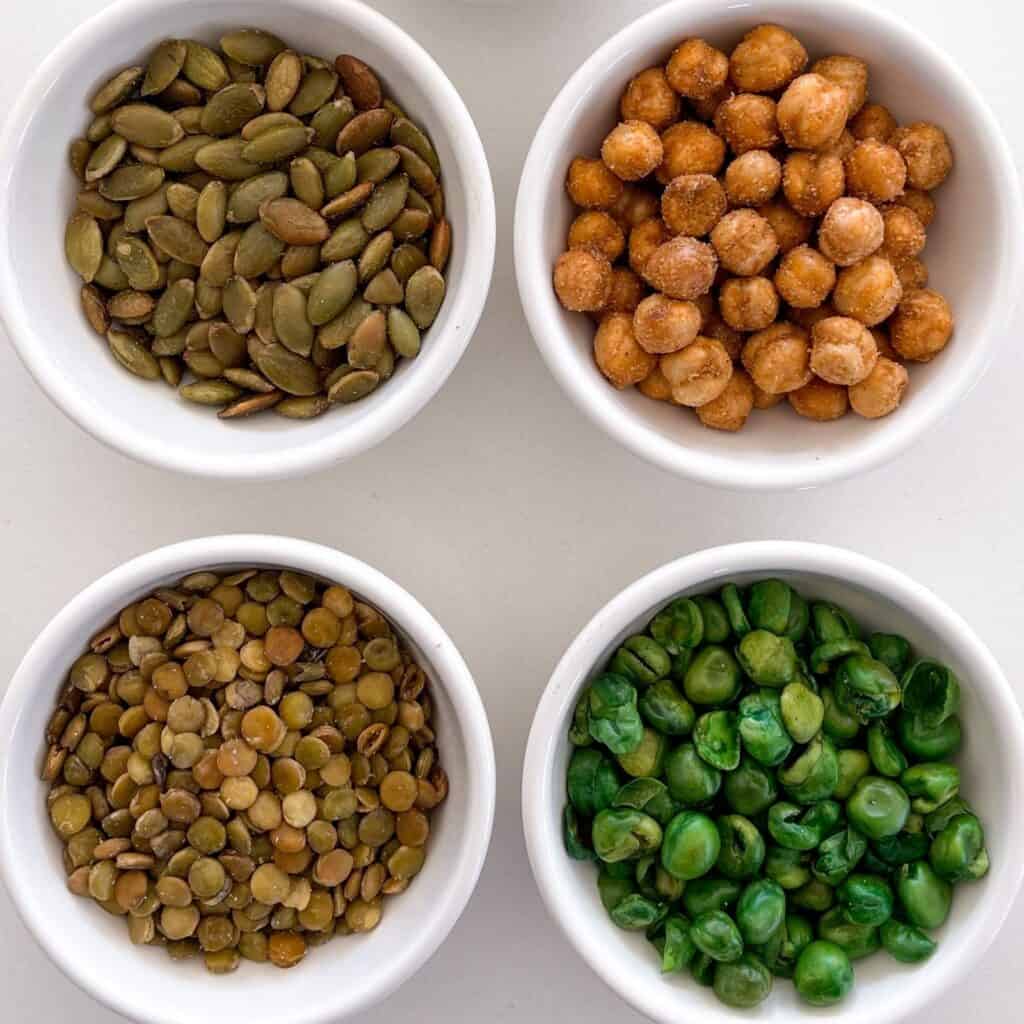
Which Nuts Have the Most Protein?
I mentioned above that nuts didn’t crack the first quarter of the 20 foods I ranked. We’ll get to the seeds and legumes below, but I wanted to put the nuts in their category. So here we go.
Ranking the Best Nuts to Eat for Protein
- Peanuts – 165 calories, 7g protein, 6g carbs, 2g fiber, 14g fat, 17% of calories from protein
- Pistachios – 160 calories, 6g protein, 8g carbs, 3g fiber, 13g fat, 15% of calories from protein
- Almonds – 165 calories, 6g protein, 6g carbs, 4g fiber, 14g fat, 15% of calories from protein
- Cashews – 165 calories, 4g protein, 9g carbs, 1g fiber, 13g fat, 10% of calories from protein
- Walnuts – 180 calories, 4g protein, 5g carbs, 2g fiber, 17g fat, 9% of calories from protein
- Hazelnuts – 180 calories, 4g protein, 5g carbs, 2g fiber, 17g fat, 9% of calories from protein
- Brazil Nuts – 190 calories, 4g protein, 3g carbs, 2g fiber, 19g fat, 8% of calories from protein
- Pine Nuts – 190 calories, 4g protein, 4g carbs, 1g fiber, 19g fat, 8% of calories from protein
- Pecans – 200 calories, 3g protein, 4g carbs, 3g fiber, 21g fat, 6% of calories from protein
- Coconut – 100 calories, 1g protein, 4g carbs, 3g fiber, 10g fat, 4% of calories from protein
- Macadamia Nuts – 205 calories, 2g protein, 4g carbs, 2g fiber, 22g fat, 4% of calories from protein
You can see the list get more buttery and unctuous as you read, right? Do you feel validated now that you know the amount of protein in almonds and walnuts puts them in the top half? Personally, I was surprised to see cashews and walnuts near the top.
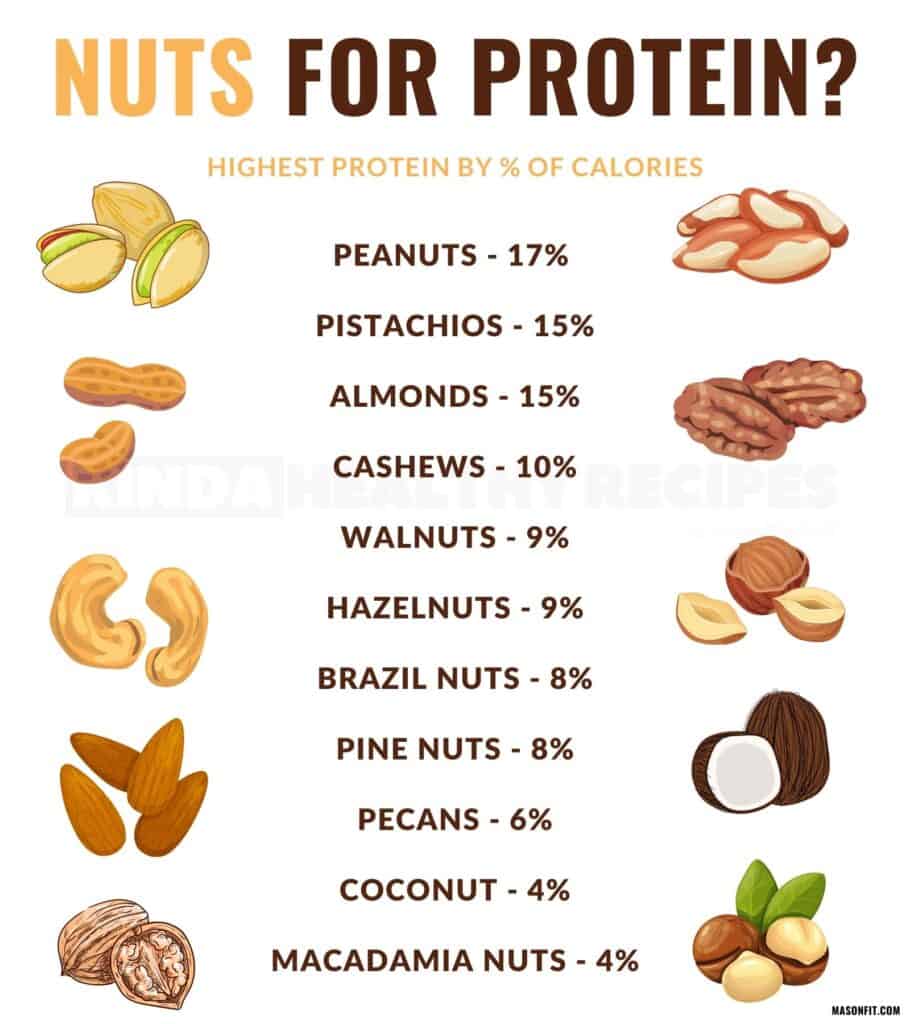
We may be splitting hairs a bit with a breakdown like this, but you can see how it’s more feasible to work pistachios, almonds, cashews, and walnuts into a high protein diet without blowing your daily fat intake.
Difficult, maybe. But not impossible.
Legumes and Seeds High in Protein
Numbers 1-6 on this list have a higher percentage of calories coming from protein than the highest protein nut from above—peanuts. If you’re currently using nuts as a crunchy snack and are looking to get more protein in your diet, I’d highly suggest adding seeds and legumes. They’re the closest thing to a high protein, low fat nut option.
Just as a reminder, the nutrition information below is for 1-ounce servings of dry roasted versions of each food.
Ranking the Best Seeds to Eat for Protein
- Edamame – 130 calories, 14g protein, 9g carbs, 6g fiber, 5g fat, 43% of calories from protein
- Lentils – 100 calories, 7g protein, 19g carbs, 6g fiber, 1g fat, 28% of calories from protein
- Fava Beans – 110 calories, 6g protein, 11g carbs, 3g fiber, 5g fat, 22% of calories from protein
- Green Peas – 120 calories, 6g protein, 17g carbs, 7g fiber, 3g fat, 20% of calories from protein
- Pumpkin Seeds – 165 calories, 8g protein, 4g carbs, 2g fiber, 14g fat, 19% of calories from protein
- Chickpeas – 100 calories, 5g protein, 15g carbs, 5g fiber, 2g fat, 18% of calories from protein
- Sunflower Seeds – 165 calories, 7g protein, 6g carbs, 2g fiber, 14g fat, 17% of calories from protein
- Chia Seeds -140 calories, 5g protein, 12g carbs, 10g fiber, 9g fat, 14% of calories from protein
- Sesame Seeds – 160 calories, 5g protein, 7g carbs, 4g fiber, 14g fat, 13% of calories from protein
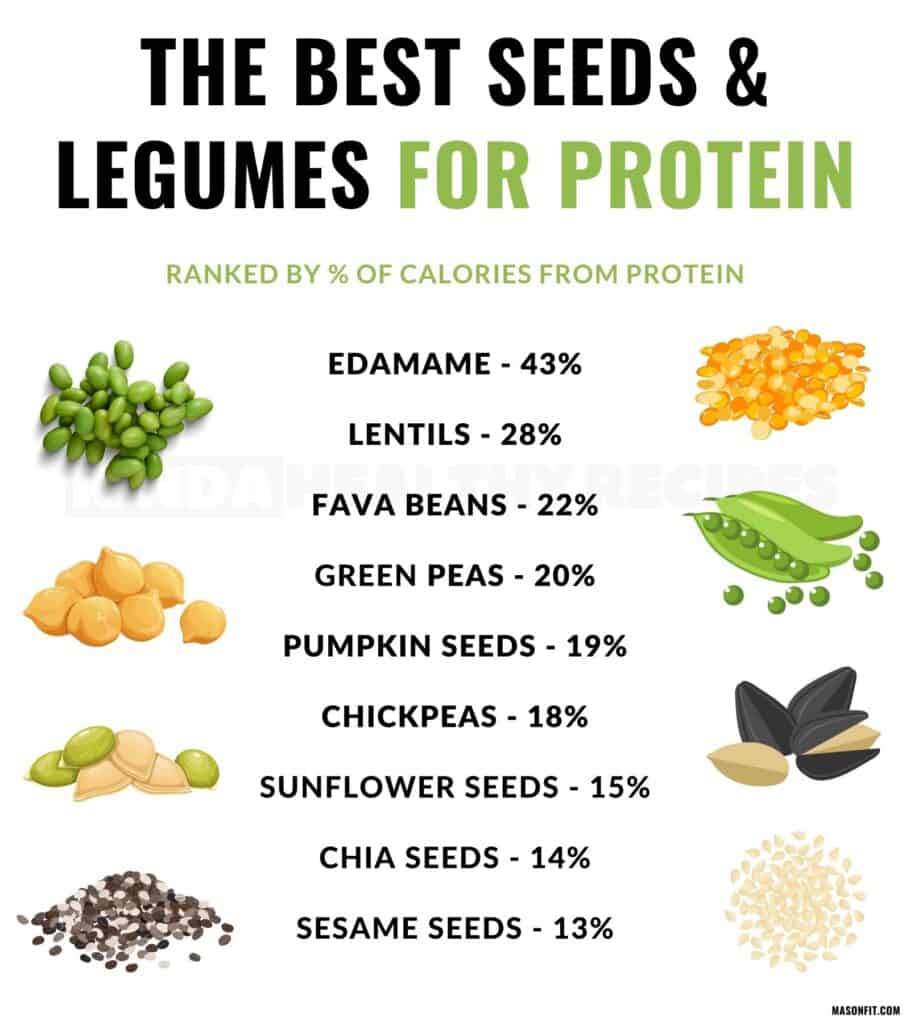
If you’re wondering about flaxseed or any other seed that’s typically ground up or mixed in with other things, it likely falls in the same 15% protein range as the other seeds on this list.
The Complete Protein Source Power Rankings
Below you’ll find all 20 nuts, seeds, and legumes I ranked based on the percentage of calories in a serving that come from protein.
- Edamame – 43%
- Lentils – 28%
- Fava Beans – 22%
- Green Peas – 20%
- Pumpkin Seeds – 19%
- Chickpeas – 18%
- Peanuts – 17%
- Pistachios – 15%
- Almonds – 15%
- Sunflower Seeds – 15%
- Chia Seeds – 14%
- Sesame Seeds – 13%
- Cashews – 10%
- Walnuts – 9%
- Hazelnuts – 9%
- Brazil Nuts – 8%
- Pine Nuts – 8%
- Pecans – 6%
- Coconut – 4%
- Macadamia Nuts – 4%
And there you have it—the highest protein nuts and seeds. While they aren’t necessarily high protein foods, you can definitely work them into a macro friendly, high protein diet.
What to Make with Nuts and Seeds
Due to the fat content I’ve mentioned already, I don’t cook with nuts and seeds that often. I usually use them as snack foods and worked into recipes like the protein trail mix mentioned earlier. That said, here’s a handful of recipes from my site where you could work micronutrient dense nuts and seeds into a high protein diet.
- My Ultimate Healthy Brownies (almond butter)
- Butterfinger Protein Oatmeal (a great introduction to lower fat powdered peanut butter)
- Healthy Dan Dan Noodles (peanut sauce + roasted peanuts)
- High Protein Double Tree Cookies (walnuts)
- Roasted Butternut Squash Soup (topped with pumpkin seeds)

- Sweet and Spicy Firecracker Ground Chicken (topped with sesame seeds)
- Homemade High Protein Granola (work any nuts and seeds into the recipe)
- Air Fried Green Beans (work slivered almonds in)
- Peanut Butter Swirl Protein Banana Bread (made with the real deal nut butter)
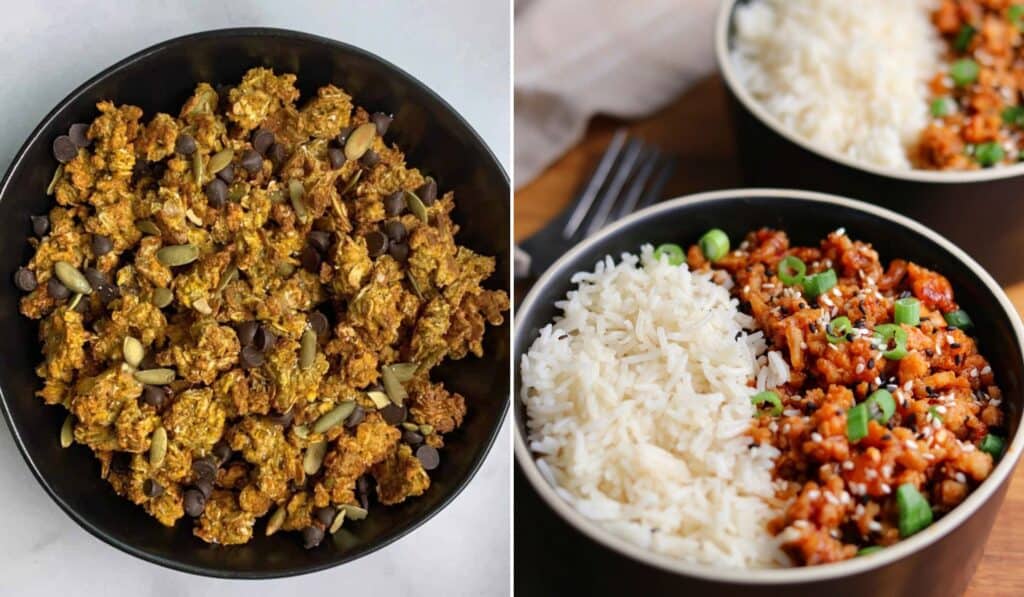
Now, take your list of the highest protein nuts and seeds and, well, go nuts! Let me know if you have any questions in the comments.
And if you enjoyed this guide, you should check out my low carb potato substitutes guide next. You’ll find a similar breakdown for all 9 options with 50+ recipes to learn how to swap them for potatoes.
